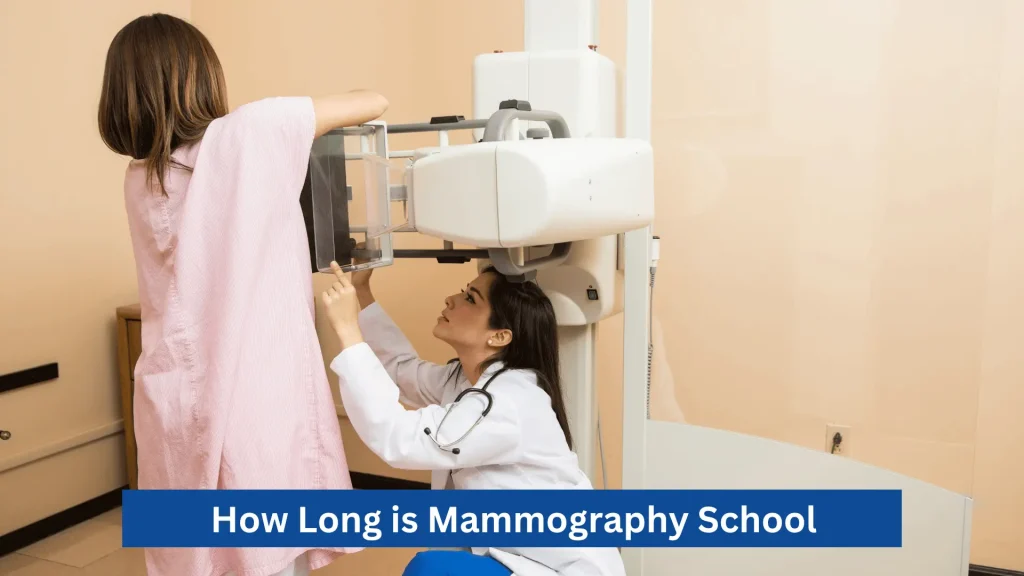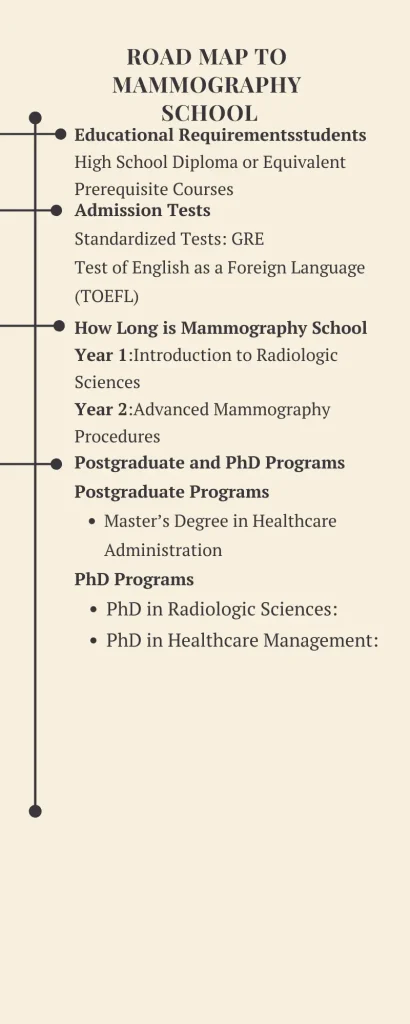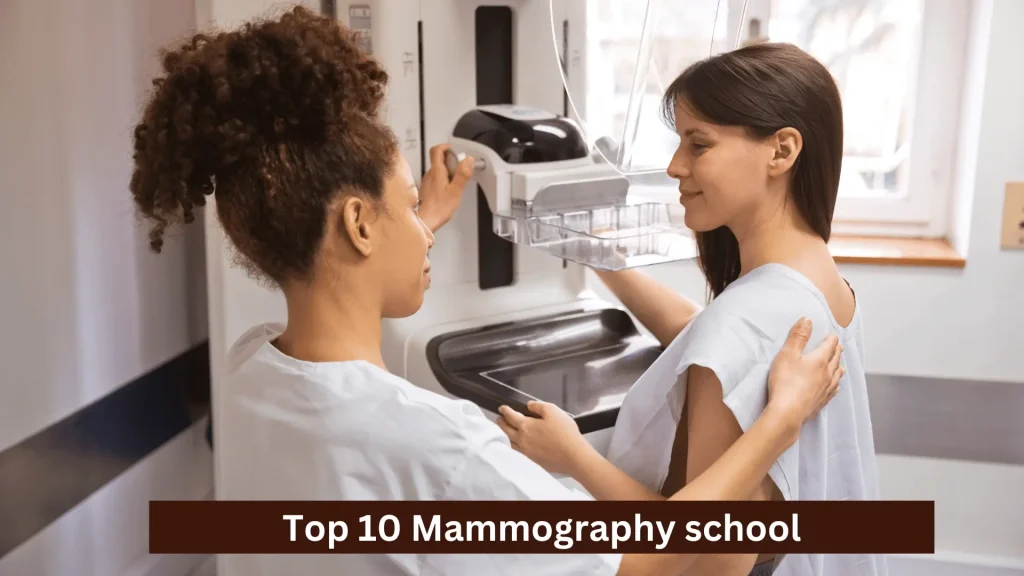How Long is Mammography School
How Long is Mammography School? Typically, it ranges from 1 to 2 years, depending on the program and whether it’s pursued full-time or part-time. These programs are designed to provide comprehensive training in mammographic imaging techniques, preparing students for certification and careers in the field.
What is Mammography School
Mammography school is an educational program that trains students to become certified mammography technologists. These programs cover the technical and clinical aspects of mammography, including the operation of imaging equipment, patient care, and the interpretation of mammograms. Students also learn about breast anatomy, pathology, and radiation safety.

Graduates of mammography school are prepared to work in various healthcare settings, such as hospitals, clinics, and diagnostic imaging centers. The training typically includes both classroom instruction and hands-on clinical experience, ensuring students are well-equipped to perform mammographic procedures and contribute to the early detection of breast cancer.
How Long is Mammography School
Year 1: Introduction to Radiologic Sciences
- Introduction to Radiologic Sciences: Students start with foundational courses in radiologic sciences, covering basic principles of imaging, anatomy, and patient care.
- Basic Mammography Techniques: Introduction to mammography, focusing on the operation of mammographic equipment and basic imaging techniques.
- Radiation Safety and Protection: Courses on radiation physics and safety protocols to ensure the protection of patients and technologists.
- Clinical Observation: Students begin observing procedures in a clinical setting to gain a preliminary understanding of the workflow and patient interactions.
Year 2: Advanced Mammography Procedures
- Advanced Mammography Procedures: In-depth study of advanced mammographic techniques, including digital mammography and breast tomosynthesis.
- Breast Pathology and Anatomy: Detailed courses on breast anatomy, common pathologies, and how they appear in mammographic images.
- Patient Care and Communication: Training in patient communication skills, emphasizing empathy and patient comfort during mammographic procedures.
- Clinical Practicum: Extensive hands-on clinical experience, where students perform mammographic procedures under the supervision of experienced technologists. This practical training is crucial for developing competency and confidence in the field.
- Preparation for Certification: Review courses and practice exams to prepare students for certification exams, such as those offered by the American Registry of Radiologic Technologists (ARRT).

By the end of the program, students are equipped with the knowledge and practical skills necessary to begin a career as a certified mammography technologist.
How to Enter Mammography School
Educational Requirements for Mammography School
High School Diploma or GED:
A minimum requirement is a high school diploma or equivalent (GED).
Courses in math, biology, and physics are beneficial.
Prerequisite Coursework:
Some programs may require completion of prerequisite courses such as anatomy, physiology, and medical terminology.
Entry Tests for Mammography School
Standardized Tests:
Some programs might require standardized test scores, such as the SAT or ACT.
Placement Exams:
Placement exams in subjects like math and English to assess readiness for college-level coursework.
Interview:
An interview may be part of the application process to assess communication skills and motivation.
Application Process for Mammography School
Application Form:
Complete and submit the application form online or in person.
Transcripts:
Provide official high school transcripts and any college transcripts if applicable.
Letters of Recommendation:
Submit letters of recommendation from teachers, employers, or healthcare professionals.
Personal Statement:
Write a personal statement explaining your interest in mammography and your career goals.
Application Fee:
Pay the required application fee.
Financial Aids for Mammography School
Federal Financial Aid:
Complete the Free Application for Federal Student Aid (FAFSA) to determine eligibility for federal grants, loans, and work-study programs.
Scholarships:
Look for scholarships specific to radiologic sciences or healthcare fields offered by schools, professional organizations, and private foundations.
Grants:
Apply for grants that do not require repayment, such as the Pell Grant or state-specific grants.
Work-Study Programs:
Participate in work-study programs to earn money while gaining relevant work experience.
Tuition Reimbursement:
Check if current employers offer tuition reimbursement for employees pursuing further education in the healthcare field.
Payment Plans:
Many schools offer payment plans to spread tuition costs over the academic year.
Postgraduate and PhD Programs for Mammography
Postgraduate Programs:
Advanced Certificate Programs:
Focus: Specialized training in advanced mammographic techniques, such as digital breast tomosynthesis or breast MRI.
Duration: Typically 6 months to 1 year.
Eligibility: Requires a degree in radiologic sciences or a related field, with certification in mammography.
Master’s Degree in Radiologic Sciences:
Focus: Comprehensive study of advanced imaging technologies, including mammography, with an emphasis on research and leadership.
Duration: Usually 1 to 2 years.
Eligibility: Bachelor’s degree in radiologic sciences or a related field, and often certification or experience in mammography.
Master’s Degree in Healthcare Administration:
Focus: Management skills for leading mammography departments or imaging centers, including financial management and healthcare policies.
Duration: Typically 1 to 2 years.
Eligibility: Bachelor’s degree in healthcare, business, or a related field, with a background in radiology or mammography.
PhD Programs:
PhD in Radiologic Sciences:
Focus: Advanced research in imaging technologies, including mammography, with opportunities for contributions to the field through research and academic publications.
Duration: Usually 3 to 5 years.
Eligibility: Master’s degree in radiologic sciences or a related field, with strong research interests and academic qualifications.
PhD in Healthcare Management:
Focus: Advanced study of healthcare systems, policy, and management with a focus on imaging services and mammography.
Duration: Typically 3 to 5 years.
Eligibility: Master’s degree in healthcare management, business administration, or a related field.
PhD in Medical Imaging Science:
Focus: In-depth research into medical imaging technologies and methodologies, including mammography, with a focus on developing new techniques and improving existing ones.
Duration: Generally 3 to 5 years.
Eligibility: Master’s degree in medical imaging, radiologic sciences, or a related field.
Top 10 Mammography Schools

University of Texas MD Anderson Cancer Center
Location: Houston, TX
Program: Advanced Certificate in Mammography
Highlights: Renowned for its cancer treatment and research, offering advanced training in mammography.
Johns Hopkins University
Location: Baltimore, MD
Program: Master’s in Radiological Sciences with Mammography Specialization
Highlights: Offers in-depth training in radiological sciences with a focus on mammographic imaging.
University of California, San Francisco (UCSF)
Location: San Francisco, CA
Program: Advanced Certificate in Breast Imaging
Highlights: Known for its comprehensive breast imaging program and research in radiology.
Columbia University
Location: New York, NY
Program: Master’s in Radiologic Sciences
Highlights: Provides specialized training in mammography and other imaging modalities.
University of Pennsylvania
Location: Philadelphia, PA
Program: Master’s in Health Administration with a focus on Radiologic Sciences
Highlights: Offers management training with an emphasis on imaging services.
Cleveland Clinic
Location: Cleveland, OH
Program: Advanced Certificate in Mammography
Highlights: Offers hands-on experience in a leading healthcare facility known for its advanced imaging technologies.
University of North Carolina at Chapel Hill
Location: Chapel Hill, NC
Program: Master’s in Radiologic Science with Breast Imaging Specialization
Highlights: Provides a comprehensive curriculum focusing on advanced mammographic techniques.
Thomas Jefferson University
Location: Philadelphia, PA
Program: Master’s in Radiologic Sciences with Advanced Imaging Options
Highlights: Offers specialized training in mammography and other advanced imaging technologies.
New York University (NYU)
Location: New York, NY
Program: Advanced Certificate in Mammography
Highlights: Known for its rigorous academic standards and advanced imaging training.
Oregon Health & Science University
Location: Portland, OR
Program: Master’s in Medical Imaging with a focus on Mammography
Highlights: Provides a strong emphasis on clinical practice and research in mammographic imaging.
These institutions offer a range of programs, from advanced certificates to master’s degrees, that provide specialized training in mammography and related fields.
Factors Affecting the Length of Mammography School
Program Type:
Certificate Programs: Typically 6 months to 1 year, focusing on specialized training in mammography.
Associate Degree Programs: Usually 2 years, offering broader education in radiologic sciences with a mammography concentration.
Bachelor’s Degree Programs: Generally 4 years, including general education and advanced imaging courses, with a focus on mammography.
Full-Time vs. Part-Time Enrollment:
Full-Time: Accelerates the completion time, allowing students to finish programs faster.
Part-Time: Extends the duration, accommodating students who need to balance studies with work or other responsibilities.
Clinical Experience Requirements:
Programs with extensive clinical practicum requirements may take longer due to the need for hands-on training in various healthcare settings.
Prerequisite Coursework:
Completion of prerequisite courses in radiologic sciences or related fields can impact the overall length of the program, especially if these need to be completed before entering the mammography-specific coursework.
Accreditation and Certification:
Accredited programs may have rigorous standards and additional requirements, potentially influencing the length of the program to ensure comprehensive training and certification readiness.
Program Structure:
Accelerated Programs: Designed for quicker completion with intensive coursework and clinical training.
Traditional Programs: Follow a standard academic calendar, which may extend the duration due to the pacing of courses and clinical rotations.
Student’s Background:
Prior Education and Experience: Students with previous radiologic science education or experience may be able to complete mammography training more quickly due to advanced standing or credits.
Institutional Differences:
Variations in curriculum design, scheduling flexibility, and institutional resources can affect the length of the program. Different schools may have different structures and timelines.
Final Verdict
The length of mammography school varies based on program type, enrollment status, clinical requirements, and prior education. Understanding these factors helps prospective students choose the right path to become proficient mammography technologists.
FAQs
1.How long does a certificate program in mammography take?
Typically 6 months to 1 year, focusing on specialized training.
2.What is the difference between a certificate and a degree program in mammography?
Certificates are shorter and more focused, while degree programs provide broader education and may take 2-4 years.
3.Can I attend mammography school part-time?
Yes, part-time enrollment is available and may extend the program duration.
4.What prerequisites are needed for mammography school?
Common prerequisites include coursework in radiologic sciences or related fields.
5.How does clinical experience impact the length of mammography school?
Extensive clinical practicum can extend the program duration, providing hands-on training in various settings.
